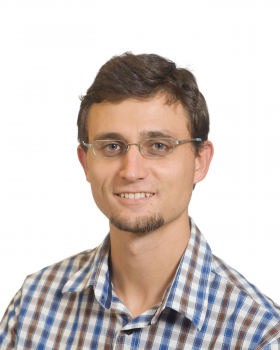Prof Tjaart Krüger

| Associate Professor | |
Department |
|
Physics |
|
| Full CV | |
| This email address is being protected from spambots. You need JavaScript enabled to view it. | |
Member of:
Research Profiles
My Students
| Primary Supervisor |
| Sarah Burnett |
My Links
I am interested in the molecular details of light harvesting and energy regulation in plants, diatoms and cyanobacteria. I want to deeply understand the factors that determine the photosynthetic efficiency of these organisms, considering that enormous energy losses occur during the very first steps of photosynthesis, i.e. in the light-harvesting antenna complexes, due to regulatory dissipation, a collection of molecular processes known as non-photochemical quenching.
My research group investigates the detailed photophysical processes of the light-harvesting complexes of various organisms, the plethora of energy transfer pathways and the different types of energy dissipative states. We are particularly interested in the switches between light-harvesting and photoprotective, energy-dissipative states and investigate various ways to control these switches, using, for example, light pulses of different shapes as well as gold nanoparticles. Our goal is to determine to what extent the photosynthetic efficiency can be enhanced, insight that will contribute to agricultural technologies and the development of artificial photosynthesis.
Our research is done in a strong multidisciplinary setting at the confluence of physics, biology and chemistry. Postgraduate students in the group have diverse backgrounds and therefore approach the research questions from many different angles.
Our main experimental tool is optical spectroscopy, a very sensitive and diverse technique. We push the resolution to the extreme to gain as much information as possible. Our two main experimental techniques are single molecule spectroscopy, which allows us to perform spectroscopy on one protein complex at a time, and femtosecond laser spectroscopy, which allows us to resolve and control energy-transfer processes on timescales down to tens of femtoseconds. We are also actively developing novel methods to bridge the gap between our highly sensitive and selective spectroscopy techniques and the native environment.
We have already been able to discover new, important spectroscopic states, new thermal energy dissipating states, how protein structural disorder is used to control the finely regulated switch between light-harvesting and energy dissipative states, and how the interaction between two individual light-harvesting proteins can be controlled to establish the degree of photoprotection.
My Journal Articles
| Publication |
|---|
| van Heerden B, Vickers NA, Krüger T, Andersson S. (2022) Real-Time Feedback-Driven Single-Particle Tracking: A Survey and Perspective. Small
10.1002/smll.202107024 |
| Gwizdala M, Lebre PH, Maggs-Kölling G, Marais E, Cowan DA, Krüger TPJ. (2021) Sub-lithic photosynthesis in hot desert habitats. Environmental Microbiology
10.1111/1462-2920.15505 |
| Krüger T, Kyeyune F, Botha JL, Van Heerden B, Malý P, Van Grondelle R, Diale M, Krüger TPJ. (2019) Strong plasmonic fluorescence enhancement of individual plant light-harvesting complexes. Nanoscale 11:15139.
10.1039/c9nr04558a |
| Gwizdala M, Berera R, Kirilovsky D, Van Grondelle R, Krüger TPJ. (2016) Controlling Light Harvesting with Light. Journal of the American Chemical Society 138:11616.
10.1021/jacs.6b04811 |

